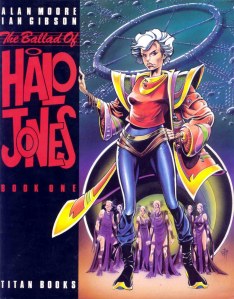1987 (Prog 503 – 554)

January (Prog 505): The vampish Durham Red makes her debut appearance in the new Strontium Dog (Grant/Ezquerra). Slaine The King and Bad Company are also appearing at this point. The Dead (Milligan/Belardinelli) begins in Prog 510.
April (Prog 516): The cover price rises to 28p.

May (Prog 520): Tenth anniversary prog! From now on 2000AD is no longer printed on newsprint but on slightly larger, highly quality paper stock. Rogue Trooper returns (Simon Geller/Steve Dillon), as does Anderson PSI (Wagner and Grant/Barry Kitson), Torquemada the God (Mills/O’Neill). Judge Dredd appears in a special Ten Years On (Wagner and Grant/Garry Leach).

Richard Burton replaces Steve MacManus as editor. MacManus has edited the comic since 1978. 2000AD develops an increasingly ‘grown-up’ sensibility in the years ahead. It is an exciting time for the Galaxy’s Greatest Comic!
June (Prog 525): D.R and Quinch’s Agony Page begins. Creator Alan Moore is no longer involved (Jamie Delano and Alan Davis/Alan Davis and Mark Farmer).

August (Prog 533): Bradley makes his first appearance in a Tharg’s Futureshock (Alan McKenzie/Simon Harrison).
(Prog 534): P.J. Maybe makes his first appearance in Judge Dredd: Bug (Wagner and Grant/Liam Sharp). Nemesis appears in an unusual one-off photo story (Mills/Photos: Tony Luke).

(Prog 535): Zenith arrives (Grant Morrison/Steve Yeowell). The character, a pop star and superhero, himself does not appear in person until Prog 536.
(Prog 537): Universal Soldier takes up arms (McKenzie/Will Simpson).
September (Prog 541): Mean Team ends (Alan Hebden/Belardinelli). Spoiler alert!: Most of the main characters are killed off.

October (Prog 545): Oz begins (Wagner and Grant/Cliff Robertson). It is the first Dredd mega-epic in five years.
November (Prog 547): Bad Company II begins (Milligan/ Brett Ewins and Jim McCarthy).
December (Prog 554): Last appearance for the old 2000AD logo.

Elsewhere:
January: Thundercats, ho! The new Thundercats cartoon debuts on Children’s BBC.
February: Be afraid. Be very afraid. David Cronenberg’s The Fly lands in the UK.
April: Star Trek IV: The Voyage Home sees the crew of the Enterprise visiting 20th century Earth. Star Trek: The Next Generation arrives on US TV this year. It does not appear on BBC Two until 1990.
Hairy alien, ALF (Alien Life Form) travels from the planet Melmac to arrive on ITV as a novel U.S sitcom about a wisecracking alien visitor.
July: Superman IV: The Quest for Peace proves a massive flop. Star Cops arrive on BBC Two.
September: Sylvester McCoy debuts as the Seventh Doctor Who. Fantasy adventure, Knightmare debuts on Children’s ITV.
October: Star Wars TV cartoon spin-off, Ewoks arrives on Children’s BBC.
November: Robocop receives its UK cinema premiere. Many see a resemblance to Judge Dredd. Predator is also released this month. Terry Pratchett’s Mort is published. Aliens in the Family debuts on Children’s BBC.
Consider Phlebas, the first of Iain M. Banks’ Culture novels and Dirk Gently’s Holistic Detective Agency, by Douglas Adams, are both published this year.
Chris Hallam is a freelance writer. Originally from Peterborough, he now lives in Exeter with his wife. He writes for a number of magazines and websites including Yours Retro, Best of British and Comic Scene – in which he wrote about Judge Death, The Ballad of Halo Jones, Dan Dare, The Eagle, Metalzoic and Alan Moore’s Watchmen. In the past, he wrote for Metro.co.uk, Radio Times, The Companion, Zarjaz, DVD Monthly and Geeky Monkey. He co-wrote the book, Secret Exeter (with Tim Isaac) and A-Z of Exeter – People, Places, History. He also provided all the written content for the 2014 annuals for The Smurfs, Furbys and Star Wars Clone Wars as well as for sections of the 2014 South Park annual and all the 2015 Transformers annual.




























































